Remember when recipes were passed down through whispered instructions over the phone, scribbled on index cards in barely legible handwriting, or simply learned by watching Mom’s hands move around the kitchen? Back in the ’60s, we didn’t have measuring cups for everything, digital scales, or YouTube tutorials to guide us through every step. Somehow, though, those dishes that came together with “a pinch of this” and “a dash of that” turned out better than anything we make today with our precise measurements and fancy gadgets.
1. Green Bean Casserole
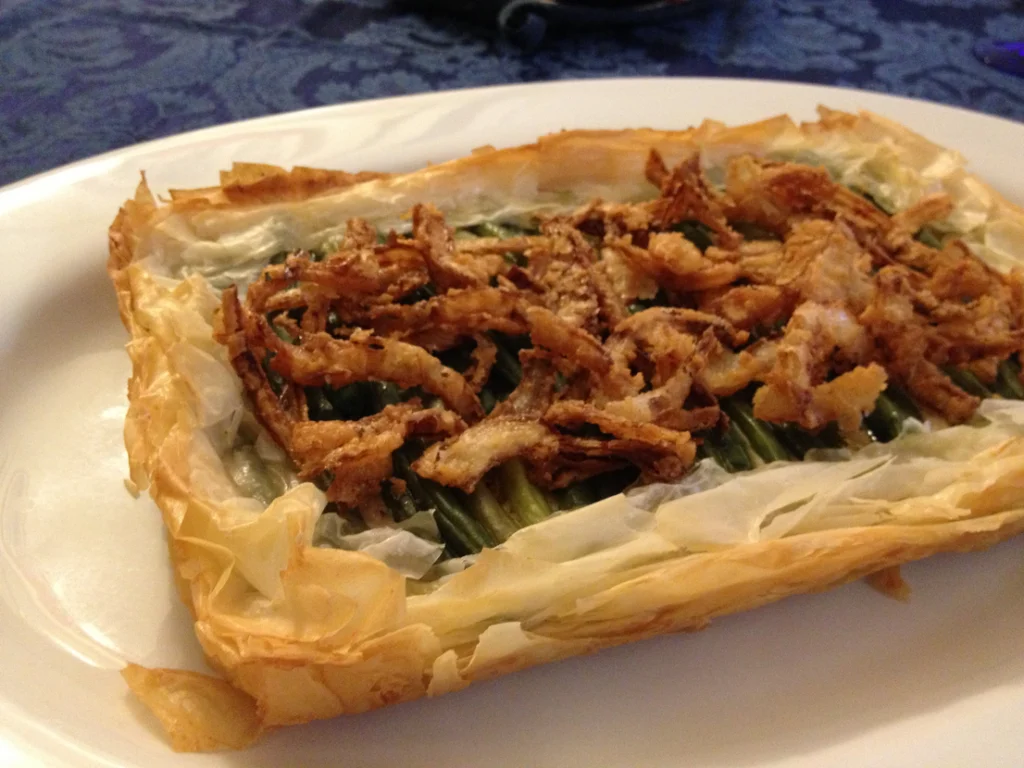
This creamy, crunchy side dish became a holiday tradition across America, combining frozen green beans, cream of mushroom soup, and those irresistible French fried onions from the can. The proportions were never measured precisely—you used enough beans to fill your casserole dish, added soup until it looked creamy, and topped it with as many fried onions as your family could handle. The beauty was in its simplicity and the way it transformed ordinary frozen vegetables into something that felt festive and special.
The dish represented everything wonderful about ’60s cooking—convenience ingredients used creatively, reliable results every time, and flavors that appealed to both kids and adults. It became such a beloved tradition that many families still refuse to serve holiday meals without it, despite decades of food trends that have come and gone. The combination of textures and flavors was pure genius, proving that sometimes the best recipes are the ones that break all the rules about fresh ingredients and scratch cooking while still delivering exactly what people want to eat.
2. Beef and Mushroom Skillet

This one-pan wonder turned simple ingredients into a sophisticated dinner that was ready in thirty minutes, perfect for busy weeknights when time was short but expectations were still high. The key was browning the beef properly, then building layers of flavor with onions, mushrooms, and whatever seasonings felt right, creating a rich, savory sauce that tied everything together. Cooks relied on their senses—the sizzle of the meat, the aroma of caramelizing onions, the look of mushrooms as they released their moisture—rather than timers and thermometers.
Served over rice, noodles, or mashed potatoes, this dish proved that weeknight dinners didn’t have to be boring or repetitive. The beauty was in its adaptability—different mushrooms, various cuts of beef, or additional vegetables could transform the basic recipe into something completely new while maintaining that essential comfort and satisfaction. It represented the best of practical cooking: delicious, reliable, and flexible enough to work with whatever ingredients you had on hand.
3. Chocolate No-Bake Cookies
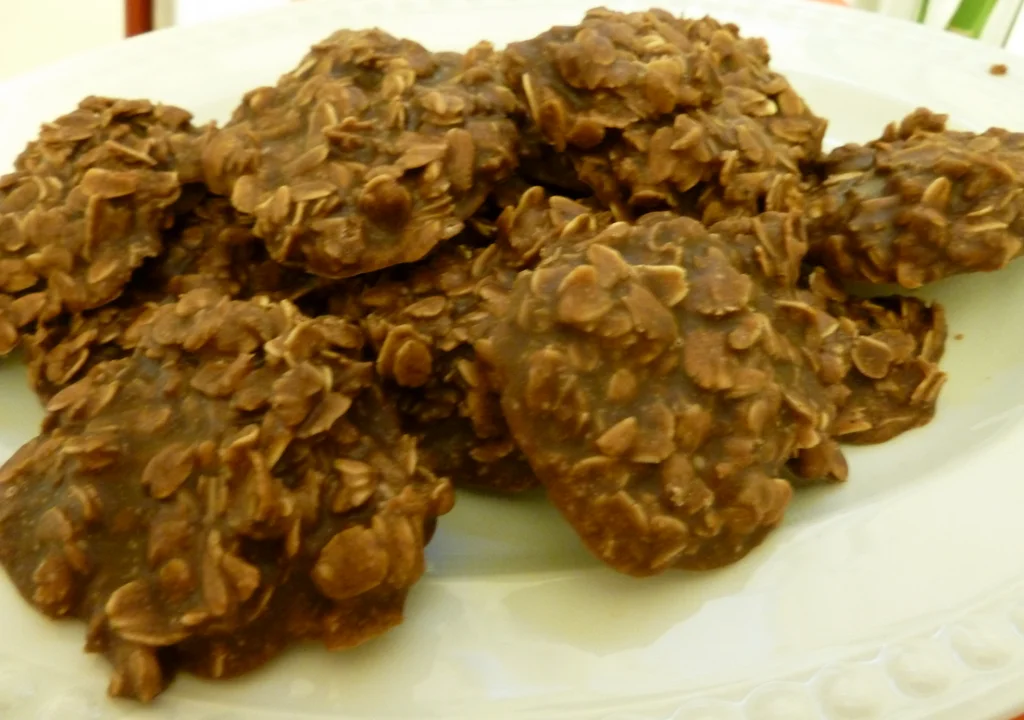
When you needed cookies fast and didn’t want to heat up the oven, these chocolate-peanut butter-oat confections were the perfect solution, ready to eat in minutes and made entirely on the stovetop. The magic happened in that brief moment when sugar, butter, milk, and cocoa came together in a rolling boil, creating a mixture that would bind with oats and peanut butter into chewy, satisfying cookies. Timing was everything—boil too long and they’d be hard, not long enough and they wouldn’t set properly—but experienced cooks developed an intuition for that perfect moment.
These cookies were a lifesaver for school bake sales, unexpected company, or simply when the cookie craving struck and patience was in short supply. Children loved helping drop spoonfuls of the mixture onto wax paper, watching the magic happen as the cookies set up before their eyes. They weren’t fancy or sophisticated, but they were reliable, delicious, and proved that sometimes the best treats are the ones that satisfy an immediate need with ingredients you already have in your pantry.
4. Sloppy Joes

This messy, delicious sandwich filling could turn a pound of ground beef into enough dinner for the whole family, served on hamburger buns with chips and maybe some pickles on the side. The sauce was a combination of ketchup, mustard, brown sugar, and whatever else seemed right—some cooks added Worcestershire sauce, others threw in a can of tomato sauce, and the adventurous might include a splash of pickle juice for tang. The beauty was in the imprecision; each cook’s version was slightly different but always recognizably perfect.
The best part about sloppy joes wasn’t just their delicious messiness or their ability to satisfy hungry kids and adults alike, but the way they brought families together around the kitchen table for a meal that was both casual and comforting. Everyone had their own technique for eating them—some tried to maintain dignity with a fork, others embraced the mess with both hands—but everyone agreed that they were the perfect solution for busy nights when you needed something hearty, economical, and guaranteed to disappear completely. They represented an era when family dinners were non-negotiable daily events, and even the simplest meals were opportunities to connect and share the day’s experiences.
5. Deviled Eggs

No party platter was complete without a dozen perfectly halved eggs with their sunny yellow filling piped or spooned into neat little mounds. The art was in achieving that perfect balance of creamy yolk, tangy mayonnaise, and just enough mustard to give them character without overwhelming the delicate egg flavor. Mothers had their own secret touches—a sprinkle of paprika, a dash of pickle juice, or even a tiny bit of horseradish for the adventurous.
These little appetizers disappeared faster than anything else at gatherings, and experienced hostesses always made extra because they knew people couldn’t resist them. The filling was mixed by feel, adjusted by taste, and piped with whatever was handy—sometimes a fancy pastry bag, but more often just a teaspoon and a steady hand. They represented the kind of simple elegance that made everyday gatherings feel special and showed that the best food didn’t need complicated techniques or exotic ingredients.
6. Chicken à la King
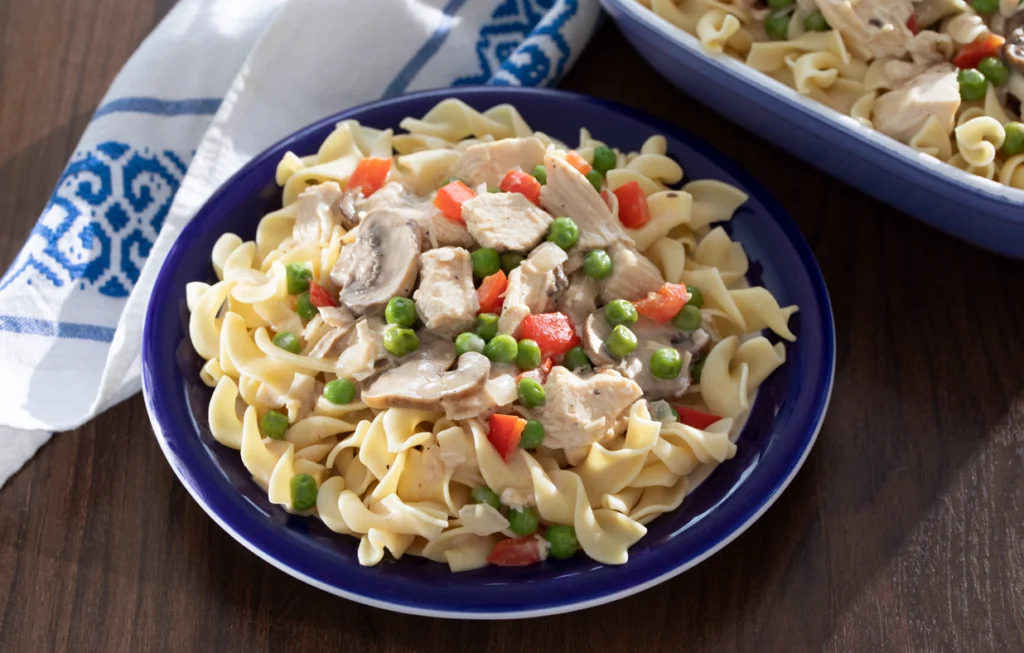
This creamy, luxurious dish turned leftover chicken into something that felt fancy enough for company, served over toast points, rice, or those delicate puff pastry shells that seemed so sophisticated. The sauce was a delicate balance of butter, flour, and cream, enriched with chicken broth and studded with peas, mushrooms, and tender chunks of chicken. Nobody wrote down exact measurements, but experienced cooks knew just how much flour to whisk into the butter and exactly when the sauce had reached that perfect, velvety consistency.
The beauty of chicken à la king was its versatility and forgiving nature—you could adjust the vegetables based on what you had on hand, and the sauce could be thickened or thinned as needed. It transformed simple ingredients into something that felt restaurant-special, perfect for Sunday dinners or when you wanted to impress guests without breaking the bank. The name alone made it sound exotic and important, even though it was really just comfort food dressed up in its Sunday best.
7. Tater Tot Casserole

This Midwestern masterpiece combined ground beef, green beans, cream of mushroom soup, and a golden crown of tater tots into one satisfying dish that pleased everyone at the table. The proportions were never exact—you used enough ground beef to feed your family, added vegetables until it looked right, and covered the whole thing with as many tater tots as would fit in a single layer. Somehow, those eyeball measurements always resulted in a perfectly balanced meal that was hearty, economical, and undeniably delicious.
The genius of tater tot casserole wasn’t just in its simplicity, but in how it elevated humble ingredients into something that felt substantial and complete. Kids loved the crispy potato topping, while adults appreciated the savory, satisfying layers underneath that provided a full meal in one dish. It was the kind of recipe that got passed between neighbors and friends, each family adding their own small variations while keeping the essential spirit of comfort and practicality that made it so enduringly popular.
8. Ambrosia Salad
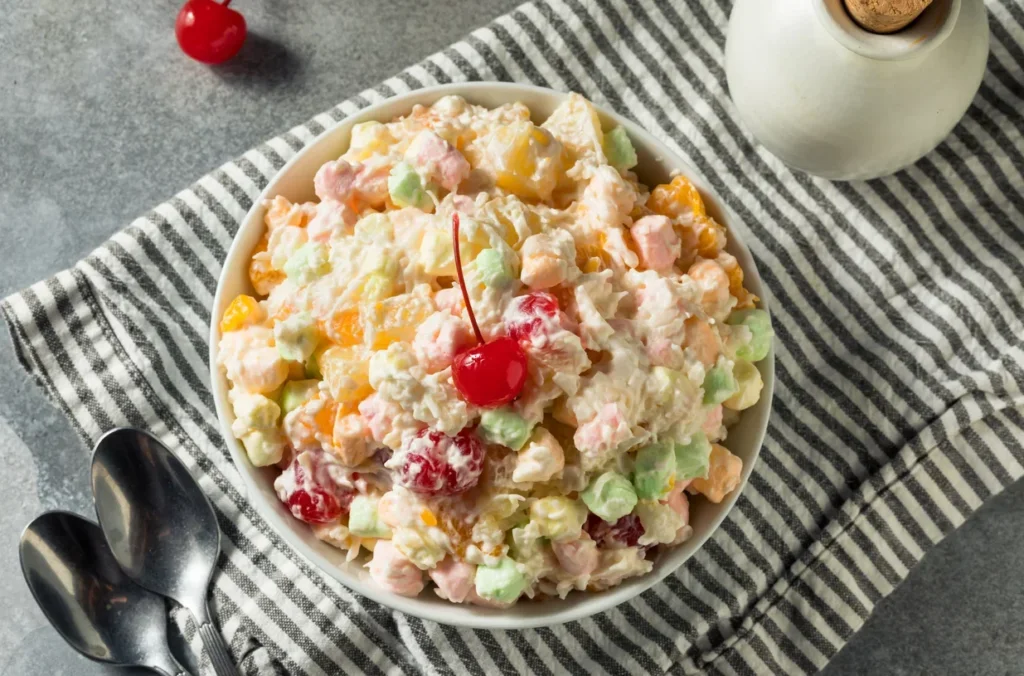
This heavenly mixture of fruits, coconut, marshmallows, and whipped cream was the crown jewel of dessert salads, appearing at every holiday meal and special occasion. The magic was in the balance—enough whipped cream to bind everything together without overwhelming the fruit, just the right amount of coconut for texture, and those tiny marshmallows that somehow made everything taste more festive. Cooks relied on their eyes and taste buds rather than measuring cups, folding ingredients together until it looked and tasted just right.
Every family had their own version, with some adding nuts, others including sour cream, and the truly adventurous throwing in exotic fruits like kiwi or star fruit when they could find them. The salad had to be made just right—too far ahead and the fruit would get watery, too late and the flavors wouldn’t meld together properly. It represented a time when dessert salads were taken seriously, when the line between salad and dessert was beautifully blurred, and when a simple combination of sweet ingredients could create something that felt truly special.
9. Meatloaf
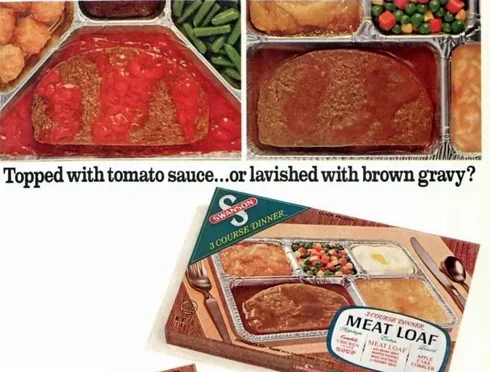
The ultimate comfort food, meatloaf was a weekly staple that could stretch a pound of ground beef to feed a family of six with plenty left over for sandwiches the next day. Every cook had their own secret combination of fillers—breadcrumbs, oatmeal, or crushed crackers—mixed with eggs, milk, and whatever seasonings felt right that day. The shaping was done by hand, the glazing was a matter of personal preference, and the cooking time was determined by experience rather than thermometers.
What made meatloaf special wasn’t its complexity but its reliability and the way it made a house smell like home. Mothers knew their ovens and trusted their instincts, creating loaves that were perfectly moist inside with just the right amount of caramelization on the outside. Served with mashed potatoes and green beans, it was the kind of meal that satisfied both body and soul, proving that the best comfort food didn’t need fancy ingredients or complicated techniques—just love, experience, and the confidence to trust your instincts.
10. Tuna Noodle Casserole
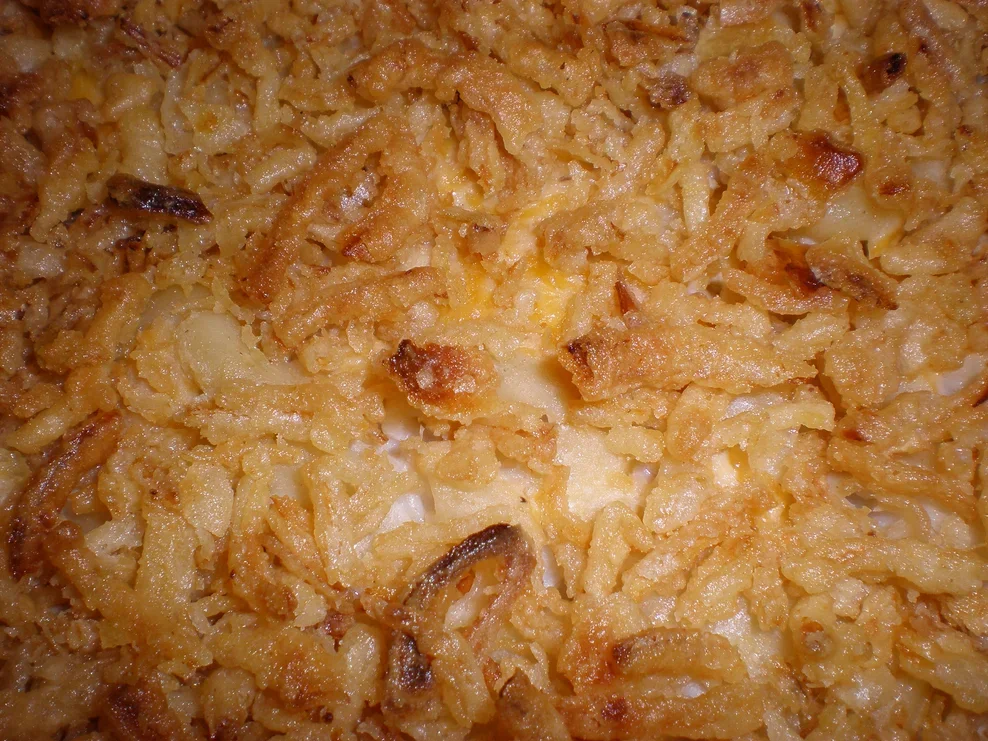
This creamy, comforting dish was the queen of weeknight dinners, appearing on tables across America whenever Mom needed something filling and fast. You’d grab a can of tuna, whatever noodles were in the pantry, and a can of cream of mushroom soup, then mix it all together with frozen peas and top it with crushed potato chips. Nobody ever measured the noodles or worried about the exact ratio of tuna to sauce, but somehow it always came out perfectly balanced and satisfying.
The beauty of tuna noodle casserole wasn’t in its sophistication—it was in its reliability and the way it brought families together around the dinner table. Kids would pick out the peas while parents savored the nostalgic comfort of a meal that stretched the grocery budget without sacrificing flavor. Even today, the smell of that golden, bubbly casserole emerging from the oven can transport you right back to childhood, when dinner was served promptly at six and everyone actually showed up to eat it.
11. Jell-O Salad with Suspended Fruit
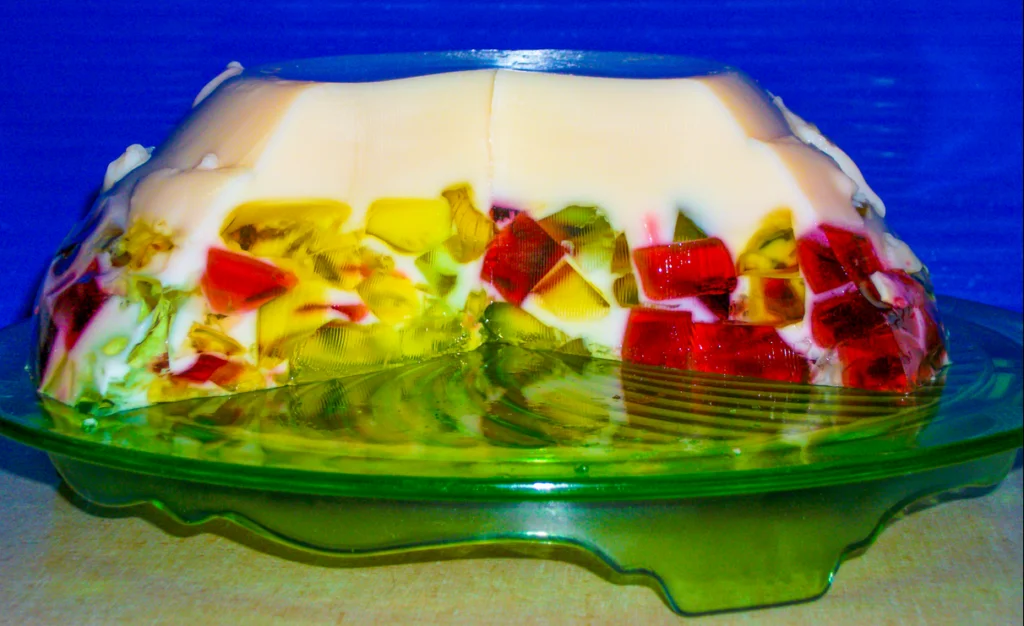
Every church potluck and family gathering featured at least three different Jell-O salads, each one a colorful masterpiece of suspended fruit, nuts, and sometimes even vegetables. The magic wasn’t in following a recipe to the letter—it was in knowing just when the gelatin had set enough to hold those pineapple chunks and mandarin oranges in perfect suspension. Mothers would eye that wobbling bowl and somehow know exactly when to fold in the whipped cream or cottage cheese without deflating the whole creation.
These shimmering salads were more than just side dishes; they were edible art that showed off a hostess’s creativity and attention to detail. The lime green version with pears was a classic, but adventurous cooks might try cherry with nuts or even that daring orange and carrot combination that somehow worked beautifully. Looking back, those Jell-O salads represented an era when presentation mattered just as much as taste, and every meal was an opportunity to create something beautiful for the people you loved.
12. Beef Stroganoff
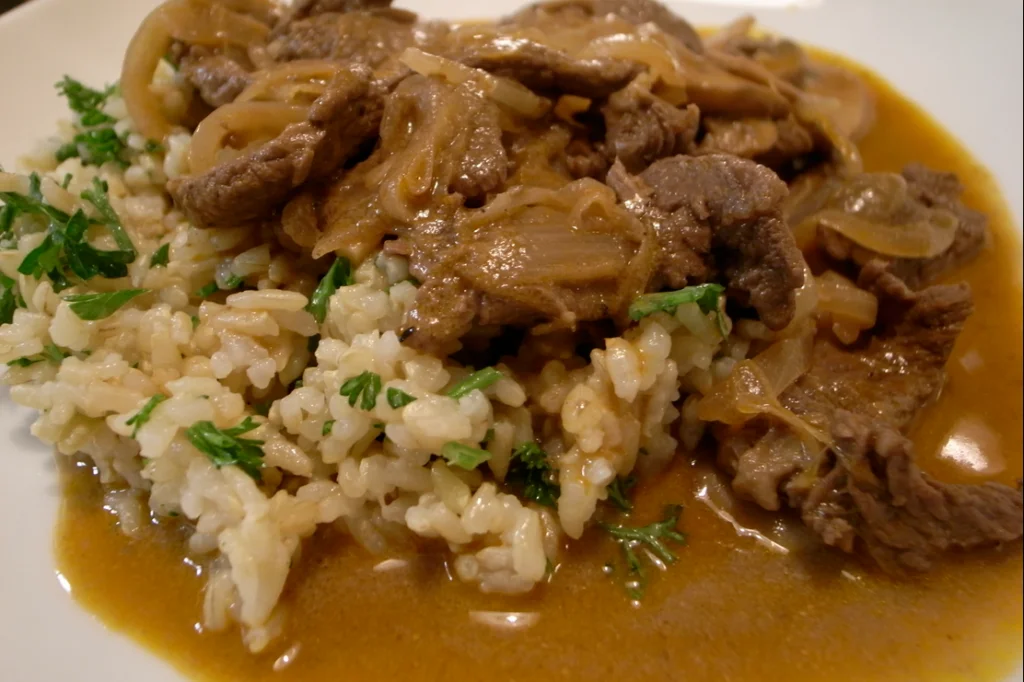
This elegant dish made weeknight dinners feel special, transforming humble ingredients into something that seemed restaurant-worthy. Mom would brown strips of beef in a hot skillet, add mushrooms and onions by sight rather than measurement, then create that signature sour cream sauce with a combination of intuition and experience. The noodles were always perfectly al dente, and the sauce was never too thick or too thin—it just worked, every single time.
The secret to great stroganoff wasn’t in precise measurements but in understanding how the ingredients worked together and trusting your senses. You could smell when the beef was perfectly browned, see when the mushrooms had released just enough moisture, and feel when the sauce had reached that perfect consistency that would coat the noodles without being gloppy. Those dinners felt sophisticated and grown-up, served on the good plates with cloth napkins, making ordinary Tuesday nights feel like celebrations.
13. Pineapple Upside-Down Cake

This showstopper dessert was pure kitchen magic—a regular cake that transformed into something spectacular when flipped out of its pan. The key was getting that butter and brown sugar mixture just right in the bottom of the pan, creating a caramelized base that would become the glossy top once inverted. Nobody measured the pineapple rings or worried about exact spacing; you just arranged them in a pattern that looked pretty and filled in the gaps with maraschino cherries.
The most thrilling moment came when you flipped that cake, holding your breath and hoping the fruit would stay perfectly in place. More often than not, it worked beautifully, creating a dessert that looked like it came from a fancy bakery but was made with pantry staples and a bit of courage. Even when a pineapple ring shifted or a cherry rolled out of place, it still tasted like pure happiness and earned you compliments that made all the effort worthwhile.
Those recipes from the ’60s worked because they were built on something more valuable than precise measurements: experience, intuition, and the kind of cooking confidence that comes from making the same dishes over and over until they become second nature. Our mothers and grandmothers didn’t need to measure every ingredient because they understood how food worked, how flavors combined, and what their families loved to eat. Maybe it’s time to put away the measuring cups once in a while and trust our senses the way they did, creating meals with our hearts and hands rather than charts and timers.
This story Nobody Measured Anything: 13 Recipes from the ’60s That Somehow Always Turned Out Right was first published on Takes Me Back.


